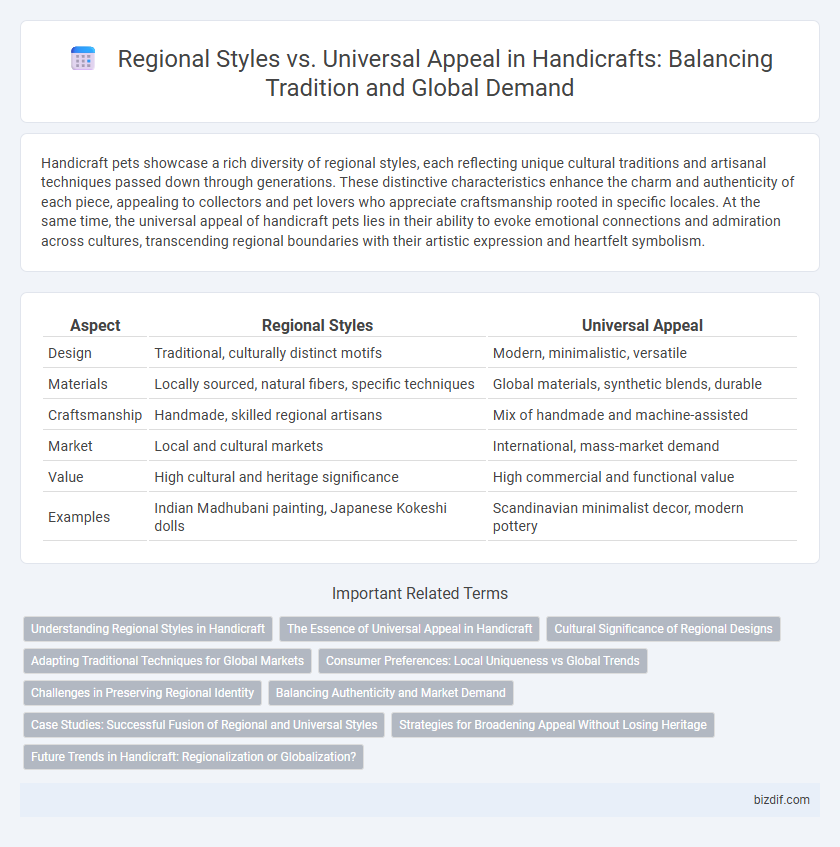Handicraft pets showcase a rich diversity of regional styles, each reflecting unique cultural traditions and artisanal techniques passed down through generations. These distinctive characteristics enhance the charm and authenticity of each piece, appealing to collectors and pet lovers who appreciate craftsmanship rooted in specific locales. At the same time, the universal appeal of handicraft pets lies in their ability to evoke emotional connections and admiration across cultures, transcending regional boundaries with their artistic expression and heartfelt symbolism.
Table of Comparison
| Aspect | Regional Styles | Universal Appeal |
|---|---|---|
| Design | Traditional, culturally distinct motifs | Modern, minimalistic, versatile |
| Materials | Locally sourced, natural fibers, specific techniques | Global materials, synthetic blends, durable |
| Craftsmanship | Handmade, skilled regional artisans | Mix of handmade and machine-assisted |
| Market | Local and cultural markets | International, mass-market demand |
| Value | High cultural and heritage significance | High commercial and functional value |
| Examples | Indian Madhubani painting, Japanese Kokeshi dolls | Scandinavian minimalist decor, modern pottery |
Understanding Regional Styles in Handicraft
Understanding regional styles in handicraft involves recognizing unique cultural motifs, traditional techniques, and locally sourced materials that define each area's artisanal identity. These regional characteristics contribute to the authenticity and heritage value of handicrafts, preserving the diverse artistic expressions rooted in community history. Mastering these distinctions enhances appreciation for craftsmanship while highlighting the importance of geographical and cultural context in design.
The Essence of Universal Appeal in Handicraft
The essence of universal appeal in handicraft lies in its ability to transcend regional styles by embodying timeless craftsmanship, intricate detailing, and culturally resonant narratives that resonate globally. Handicrafts that blend traditional techniques with contemporary aesthetics often achieve wider appreciation, bridging diverse cultural contexts while preserving authenticity. This harmonious balance between local heritage and universal themes elevates handicrafts from mere artifacts to cherished symbols of artistic expression across the world.
Cultural Significance of Regional Designs
Regional handicraft styles embody the cultural heritage and unique traditions of their communities, preserving indigenous techniques and symbolic motifs passed down through generations. These designs reflect local history, religious beliefs, and social values, enriching the products with authentic storytelling and identity. Balancing regional specificity with universal appeal enhances marketability while maintaining the integrity of cultural expression.
Adapting Traditional Techniques for Global Markets
Traditional handicraft techniques rooted in specific regional styles serve as cultural signatures that convey unique artistic heritage. Adapting these time-honored methods for global markets involves blending authentic craftsmanship with contemporary design trends and sustainable materials to meet international consumer preferences. This strategic fusion enhances marketability while preserving the cultural integrity and artisanal value embedded in regional crafts.
Consumer Preferences: Local Uniqueness vs Global Trends
Consumer preferences in handicrafts reveal a dynamic tension between regional styles and universal appeal, with many buyers seeking the authenticity and cultural richness of local uniqueness. Artisans who preserve traditional techniques and motifs from specific regions often attract niche markets that value heritage and storytelling in their purchases. Conversely, global trends drive demand for more contemporary designs that blend or reinterpret regional elements to fit broader, international aesthetics.
Challenges in Preserving Regional Identity
Preserving regional identity in handicraft faces challenges due to globalization and mass production, which often favor universal appeal over traditional techniques and designs. Artisans struggle to maintain the authenticity of intricate patterns and culturally significant motifs while adapting to broader market demands. Balancing the economic viability of handicrafts with the preservation of unique regional heritage requires innovative strategies that respect cultural origins and craftsmanship.
Balancing Authenticity and Market Demand
Regional handicraft styles preserve cultural heritage through unique techniques and materials that reflect local identity, while universal appeal requires adapting designs to broader consumer preferences without compromising authenticity. Artisans strategically blend traditional motifs with contemporary aesthetics to enhance market demand and sustain economic viability. This balance between cultural preservation and commercial success ensures the longevity and relevance of handicraft traditions globally.
Case Studies: Successful Fusion of Regional and Universal Styles
Case studies reveal that artisans merging regional handicraft styles with universal design elements significantly boost market reach and cultural appreciation. For instance, Indian Madhubani paintings integrated with contemporary motifs attract global buyers while preserving traditional techniques. Similarly, Moroccan ceramics combining local patterns with minimalist aesthetics emphasize the potential for regional crafts to achieve worldwide appeal without losing authenticity.
Strategies for Broadening Appeal Without Losing Heritage
Crafting regional styles with universal appeal involves integrating traditional motifs with contemporary design elements to resonate across diverse markets. Leveraging storytelling that highlights unique cultural origins while emphasizing shared human values creates emotional connections beyond geographic boundaries. Employing digital marketing techniques and collaborating with global artisans enable authentic heritage preservation alongside scalable brand growth.
Future Trends in Handicraft: Regionalization or Globalization?
Future trends in handicraft reveal a dynamic balance between regional styles and universal appeal, with artisans increasingly integrating traditional motifs from areas like Indian Madhubani and Japanese Sashiko into globally marketable designs. The rise of e-commerce platforms enhances cross-cultural exchange, enabling handcrafted goods from regions such as Oaxaca or Morocco to reach diverse international audiences, thus blending local authenticity with global demand. Sustainable sourcing and ethical production methods are driving consumers worldwide to appreciate handicrafts not only for their aesthetic value but also for their cultural significance and environmental impact.
Regional Styles vs Universal Appeal Infographic

 bizdif.com
bizdif.com